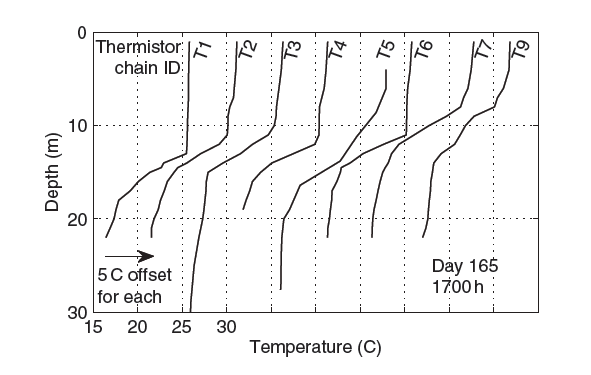Hydrodynamical Modeling
EXTRACT FROM INTRODUCTION: Hydrodynamic modeling provides insight into spatial and temporal changes in physical processes that are observed, but less clear, in field data. For example, Figure 1 shows temperature profiles simultaneously recorded at different stations around Lake Kinneret (Israel). Extracts from model results (Figure 2) provide a context for interpreting these data as a coherent tilting of the thermocline. A time series of the thermocline can be animated, showing the principal motion is a counter-clockwise rotation. The complexities of the thermocline motion can be further dissected by using spectral signal processing techniques to separate wave components, illustrating a basin-scale Kelvin wave, a first-mode Poincare wave, and a second-mode Poincare wave.
Models are generally applied to lakes, rivers, and wetlands to visualize and quantify flows, distributions, and residence times that affect water quality and ecology. Understanding the evolving physical state (e.g., surface elevation, density, temperature, velocity, turbidity) is necessary for modeling fluxes of nutrients, pollutants, or biota in time-varying fields of one, two, or three space dimensions (1D, 2D, 3D). Thermal structure is considered part of hydrodynamics because temperature affects water density, which in turn provides pressure gradients (force) that speed up or slow down a fluid (i.e., cause acceleration). Interrelationships can go even further: where phytoplankton affect the thermal structure by decreasing the depth of light penetration, both transport and the bloom/decay cycle of algae can be considered part of hydrodynamic modeling. This argument, followed to its logical conclusion, implies transport of nutrients that affect plankton growth are a part of hydrodynamics. However, the coupling between hydrodynamics and ecology is not generally a dominant effect and can be neglected in many cases.
EXTRACT: Figure 1.

Figure 1. Temperature profiles collected in Lake Kinneret in 1997 at stations shown in Figure 2. (data of J. Imberger, Centre for Water Research, University of Western Australia)
EXTRACT: Figure 2.

Figure 2. Extracted iso-surface of temperature from 3D model of Lake Kinneret for the same day and time as data in Figure 1.
